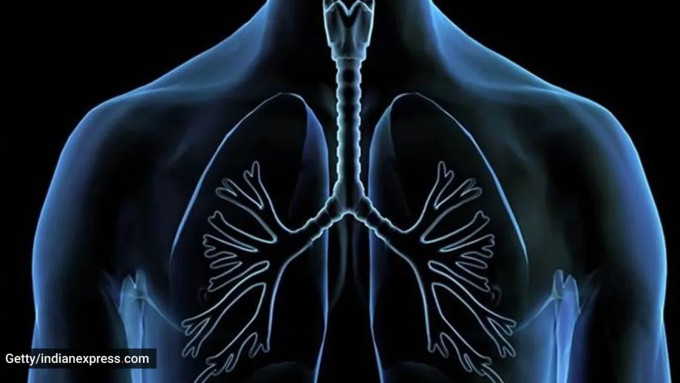Experts decode this yogic breathing practice believed to help remove ‘stale air’ from the lungs
Medical professionals often encounter patients seeking natural ways to improve their respiratory health. “One technique that frequently comes up during such consultations is Swana Pranayama, a yogic breathing practice believed to cleanse the lungs of stale air,” said Dr Arun Kotaru, consultant, respiratory/pulmonology and sleep medicine, Artemis Hospitals, Gurugram.
Content creator Adithya Nataraj shared how to perform it, especially when the air we breathe is of poor quality and is contaminated with pollutants.

*Sit in a comfortable position with your spine erect and palms on your knees
*Stick your tongue out and forcefully inhale and exhale (similar to how dogs pant)
*Perform 3 sets of 11 rounds.
Let’s understand the science behind this practice and explore its potential benefits.
Understanding the lungs
Our lungs are remarkable organs responsible for gas exchange. They take in oxygen from the inhaled air and release carbon dioxide, a waste product, during exhalation. “Millions of tiny air sacs called alveoli provide a vast surface area for this exchange to occur efficiently. However, the lungs are constantly exposed to pollutants, allergens, and irritants that can get trapped in the airways and alveoli,” said Dr Kotaru.
 This is how lungs work (Source: Getty Images/Thinkstock)
This is how lungs work (Source: Getty Images/Thinkstock)
What is stale air?
While our bodies have natural mechanisms to clear these irritants, sometimes “stale air” can refer to the residual volume of air remaining in the lungs after a normal exhalation, according to Dr Kotaru. “This air may contain less oxygen and more carbon dioxide compared to fresh air,” said Dr Kotaru.
Deep breathing exercises, in general, can help
– Improve lung capacity: By expanding the lungs to their full capacity during inhalation, Swana Pranayama may help stretch and strengthen the respiratory muscles, potentially increasing lung volume.
– Enhanced mucus clearance: The deeper breaths and stronger exhalations associated with Swana Pranayama might help mobilise and expel mucus that traps dust particles and allergens in the airways.
– Stress reduction: Deep breathing techniques like Swana Pranayama are known to activate the parasympathetic nervous system, promoting relaxation and reducing stress hormones. Stress can exacerbate respiratory problems like asthma, so this relaxation response could be beneficial.
So, is Swana Pranayama effective?
Swana Pranayama, involves a slow, deep inhalation followed by a prolonged, audible exhalation. “Proponents believe this forceful exhalation helps expel stale air from the lungs, promoting deeper breaths and improved oxygen intake,” said Dr Kotaru.
According to yoga guru Dr Mickey Mehta, the benefits of Swana Pranayama or dog breathing are:
*Strong exhalations free the lungs of toxic buildup and leftover carbon dioxide, allowing new oxygen to enter.
*Consistent practice builds lung capacity and strengthens the respiratory muscles. This can relieve bronchitis and asthma as well as improve general respiratory efficiency.
*This pranayama technique, in a rhythmic way, promotes relaxation and mental calmness. “It supports mental clarity and emotional well-being by easing tension, stress, and anxiety,” said Dr Mehta.
*Deep breathing increases oxygenation, which energises the body and mind and gives you a natural energy boost. It can improve vigour and fight weariness.
While research on Swana Pranayama specifically is limited, “there is evidence to suggest that certain breathing techniques can benefit lung health,” said Dr Kotaru. “Swana Pranayama offers a natural approach to promoting lung health. While the concept of expelling ‘stale air’ may not be entirely accurate from a purely physiological standpoint, the deeper breaths and potential for improved mucus clearance could offer some benefits,” said Dr Kotaru.
View this post on Instagram
A post shared by Adithya Nataraj 🇮🇳 (@learnwithadithya)
Things to keep in mind
It’s important to note that Swana Pranayama is not a replacement for conventional medical treatment for respiratory conditions, Dr Kotaru cautioned. “If you have any underlying lung issues, consult your doctor before attempting this practice. Additionally, the forceful exhalation might not be suitable for everyone, especially those with certain medical conditions,” said Dr Kotaru.
📣 For more lifestyle news, click here to join our WhatsApp Channel and also follow us on Instagram
Disclaimer: The copyright of this article belongs to the original author. Reposting this article is solely for the purpose of information dissemination and does not constitute any investment advice. If there is any infringement, please contact us immediately. We will make corrections or deletions as necessary. Thank you.

